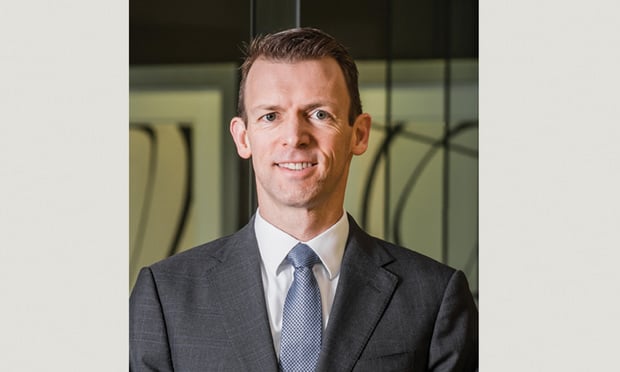Legal Defenses for Employers in COVID-19 Litigation in California
Although lawsuits are a certainty, liability is not. Any lawsuit seeking damages for COVID-19 injuries must surmount several procedural and substantive legal hurdles, says Alston & Bird's Matt Wickersham.
June 30, 2020 at 07:40 PM
7 minute read
 Matt Wickersham is a partner at Alston & Bird in Los Angeles in the firm's environment, land use and natural resources group. Photo: Courtesy Photo
Matt Wickersham is a partner at Alston & Bird in Los Angeles in the firm's environment, land use and natural resources group. Photo: Courtesy Photo
Businesses in California and across the country have been economically decimated by the shelter-in-place orders established to mitigate the health impact from the COVID-19 virus. Now that more businesses are reopening despite persistent detections of COVID-19 throughout the state, we can expect to see more and more lawsuits alleging that operations at a business resulted in employees becoming infected and made sick by the COVID-19 virus. These lawsuits will undoubtedly allege that businesses failed to take sufficient precautions to address the risk posed by the coronavirus.
But while lawsuits are a certainty, liability is not. Any lawsuit seeking damages for COVID-19 injuries must surmount several procedural and substantive legal hurdles.
Workers' Compensation Is Generally the Exclusive Remedy for Occupational Injuries
In general, employees are entitled to compensation from the workers' compensation program if they can show that their injury was sustained at the workplace. For infectious diseases, especially those widespread in the general population, it will be difficult for employees to show that they contracted the disease as a consequence of their employment. California law (such as Labor Code Sections 3212.6, 3212.8 and 3212.9) has previously held that certain types of workers should be presumed to have sustained certain types of disease in the normal course of their employment. There are several bills pending in the legislature that propose establishing similar presumptions for other workers, such as first responders, health care workers and essential workers.
Gov. Gavin Newsom blew past these legislative proposals by mandating in an executive order that all employees who test positive for COVID-19 are presumed to have acquired the disease as an occupational disease if they worked at a jobsite outside their home at the direction of their employer between March 19 and July 5 and they tested positive for COVID-19 within 14 days of working at their jobsite.
While it's unclear whether this executive order will be extended, employees currently working within the state will be presumed to have incurred any coronavirus infection at the workplace for purposes of awarding workers' compensation benefits. While employers can rebut that presumption, that would be difficult to show without evidence that the worker has been acting carelessly outside of work, raising the prospect that employers must now monitor the activity of employees outside the workplace in order to respond to claims that an employee contracted COVID-19 at the workplace.
While Newsom's order drastically widened the scope of potential workers' compensation claims, it will limit the scope of broader legal liability for claims by employees. Claims for personal injury are typically barred if the alleged injury falls under workers' compensation. While there are exceptions to this exclusivity doctrine (for example, an employer may still be liable for aggravation of a disease, as opposed to concealment of the hazards of the employment that caused the employee to contract the disease), workers' compensation should be deemed the exclusive remedy for lawsuits brought by employees seeking damages because they were infected with COVID-19 as a result of their employment. This is a result of the "compensation bargain," where "the employer assumes liability for industrial personal injury or death without regard to fault in exchange for limitations on the amount of that liability. The employee is afforded relatively swift and certain payment of benefits to cure or relieve the effects of industrial injury without having to prove fault but, in exchange, gives up the wider range of damages potentially available in tort." (Charles J. Vacanti, M.D. v. State Comp. Ins. Fund, 24 Cal. 4th 800 (2001).)
The exclusivity provision of the workers' compensation regime will preclude the majority of lawsuits filed over COVID-19 infections. Expect to see many efforts by plaintiffs lawyers to circumvent this exclusivity provision. For example, vendors or customers may not be precluded from filing lawsuits claiming exposure at a workplace where they are not an employee. However, it will be difficult for transient visitors to prove that any infection was caused from a fleeting visit.
Plaintiffs lawyers will also likely argue that the exclusivity bar does not prevent lawsuits against parent companies that take direct action that aggravate an injury. However, this exception would have little practical effect if the operating subsidiaries have discretion to determine the necessary public health precautions that should be taken.
Instead, employees are increasingly bringing claims under the public nuisance doctrine. A claim for public nuisance is frequently used by neighboring properties to compel a facility to remediate or abate environmental contamination that is causing harm to the general public. Here, public nuisance should not be allowed to sidestep the exclusivity doctrine when the alleged harm to the plaintiffs is from occupational exposure to COVID-19.
Compliance With Governmental Regulations Is Generally a Defense to Lawsuits Based on Public Nuisance
Another significant defense to COVID-19 lawsuits will be an employer's compliance with applicable regulatory standards and guidelines. As discussed in the prior article from my colleagues Gregg Loubier and Sue Chang, state and local guidelines have established detailed schemes for when and how businesses may reopen in California. Compliance with these guidelines will often provide a defense against actions alleging that a business's operations constitute a nuisance.
California law provides that "Nothing which is done or maintained under the express authority of a statute can be deemed a nuisance." In interpreting this rule, courts have distinguished between governmental standards that authorize the activity being challenged and those that regulate the manner in which the activity must take place. Even if a statute authorizes an activity, courts have frequently held that a business can still be liable for nuisance if the manner in which that activity takes place creates a nuisance to its surrounding environment. But if the government has authorized both the activity and the specific manner in which that activity must take place with the intent that its authorization should displace traditional nuisance liability, then the courts may not interfere with the officially sanctioned activity.
Here, the reopening guidelines being adopted by federal, state and local governments vary widely in their specificity and mandatory effect. These guidelines are also updated frequently and often with little advance notice. In fact, Los Angeles County allowed restaurants to reopen before even issuing the guidelines that these restaurants were expected to follow. Clearly, it is a challenge for businesses to stay in compliance with all applicable guidelines. But if the controlling guidelines specifically dictate the manner in which businesses should conduct their operations to minimize COVID-19 exposures, compliance with these provisions should act to shield a company from tort liability. Even if a court finds that compliance is not dispositive, it would remain compelling evidence in determining whether a business acted unreasonably if a COVID-19 hot spot can be traced back to its operations. On the other hand, businesses should be cognizant that even complete compliance with reopening guidelines may not be sufficient to avoid liability if a court concludes that the guidelines are too vague or that greater precautions should have been taken. For that reason, industry standards will likely play a significant role in determining what actions should be considered reasonable.
In short, responding to and avoiding COVID-19 lawsuits require a comprehensive strategy, applying well-established legal precedents to a rapidly changing social and economic landscape.
Matt Wickersham is a partner at Alston & Bird LLP in Los Angeles in the firm's Environment, Land Use & Natural Resources group. He handles a wide range of matters involving environmental regulation and mass tort litigation, including claims of environmental contamination, personal injury, wrongful death and nuisance liability.
This content has been archived. It is available through our partners, LexisNexis® and Bloomberg Law.
To view this content, please continue to their sites.
Not a Lexis Subscriber?
Subscribe Now
Not a Bloomberg Law Subscriber?
Subscribe Now
NOT FOR REPRINT
© 2025 ALM Global, LLC, All Rights Reserved. Request academic re-use from www.copyright.com. All other uses, submit a request to [email protected]. For more information visit Asset & Logo Licensing.
You Might Like
View All

Law Firms Mentioned
Trending Stories
Who Got The Work
J. Brugh Lower of Gibbons has entered an appearance for industrial equipment supplier Devco Corporation in a pending trademark infringement lawsuit. The suit, accusing the defendant of selling knock-off Graco products, was filed Dec. 18 in New Jersey District Court by Rivkin Radler on behalf of Graco Inc. and Graco Minnesota. The case, assigned to U.S. District Judge Zahid N. Quraishi, is 3:24-cv-11294, Graco Inc. et al v. Devco Corporation.
Who Got The Work
Rebecca Maller-Stein and Kent A. Yalowitz of Arnold & Porter Kaye Scholer have entered their appearances for Hanaco Venture Capital and its executives, Lior Prosor and David Frankel, in a pending securities lawsuit. The action, filed on Dec. 24 in New York Southern District Court by Zell, Aron & Co. on behalf of Goldeneye Advisors, accuses the defendants of negligently and fraudulently managing the plaintiff's $1 million investment. The case, assigned to U.S. District Judge Vernon S. Broderick, is 1:24-cv-09918, Goldeneye Advisors, LLC v. Hanaco Venture Capital, Ltd. et al.
Who Got The Work
Attorneys from A&O Shearman has stepped in as defense counsel for Toronto-Dominion Bank and other defendants in a pending securities class action. The suit, filed Dec. 11 in New York Southern District Court by Bleichmar Fonti & Auld, accuses the defendants of concealing the bank's 'pervasive' deficiencies in regards to its compliance with the Bank Secrecy Act and the quality of its anti-money laundering controls. The case, assigned to U.S. District Judge Arun Subramanian, is 1:24-cv-09445, Gonzalez v. The Toronto-Dominion Bank et al.
Who Got The Work
Crown Castle International, a Pennsylvania company providing shared communications infrastructure, has turned to Luke D. Wolf of Gordon Rees Scully Mansukhani to fend off a pending breach-of-contract lawsuit. The court action, filed Nov. 25 in Michigan Eastern District Court by Hooper Hathaway PC on behalf of The Town Residences LLC, accuses Crown Castle of failing to transfer approximately $30,000 in utility payments from T-Mobile in breach of a roof-top lease and assignment agreement. The case, assigned to U.S. District Judge Susan K. Declercq, is 2:24-cv-13131, The Town Residences LLC v. T-Mobile US, Inc. et al.
Who Got The Work
Wilfred P. Coronato and Daniel M. Schwartz of McCarter & English have stepped in as defense counsel to Electrolux Home Products Inc. in a pending product liability lawsuit. The court action, filed Nov. 26 in New York Eastern District Court by Poulos Lopiccolo PC and Nagel Rice LLP on behalf of David Stern, alleges that the defendant's refrigerators’ drawers and shelving repeatedly break and fall apart within months after purchase. The case, assigned to U.S. District Judge Joan M. Azrack, is 2:24-cv-08204, Stern v. Electrolux Home Products, Inc.
Featured Firms
Law Offices of Gary Martin Hays & Associates, P.C.
(470) 294-1674
Law Offices of Mark E. Salomone
(857) 444-6468
Smith & Hassler
(713) 739-1250








